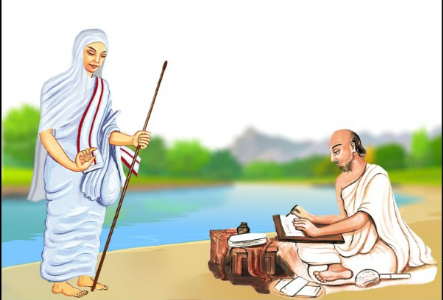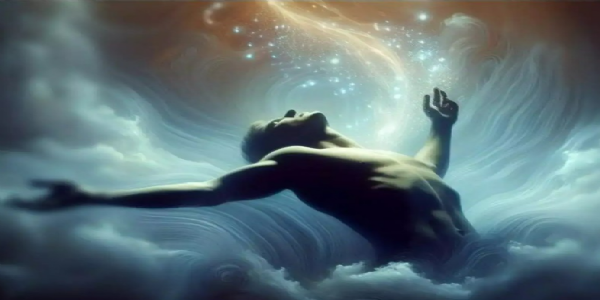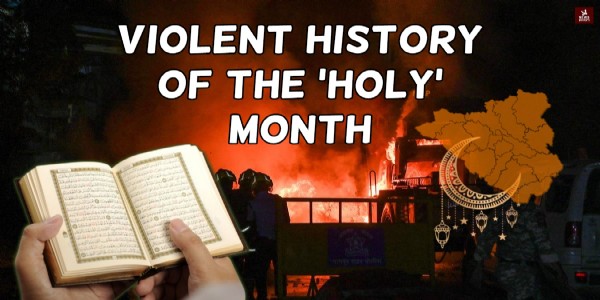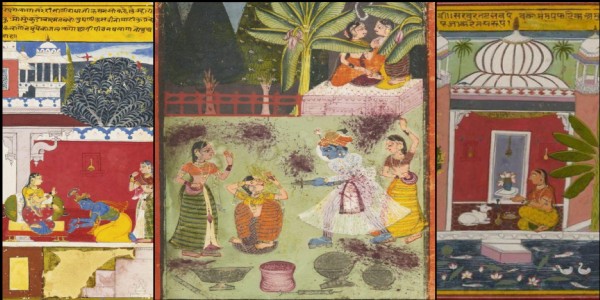Vedic Pioneering of Concepts of Science and Space: “INDIA IS ON THE MOON!”
“The landing gives confidence to configure missions to go to the Moon, Mars, Venus, maybe even asteroids”, ISRO chair S. Somanath said at a press briefing”
Total Views | 399
“India is on the moon!" ISRO chairman Dr. Sreedhara Somanath announced after the historic soft landing of India’s Lunar spacecraft Chandrayan-3 near the South Pole of the Moon on August 23 2023.(Ref. 1).
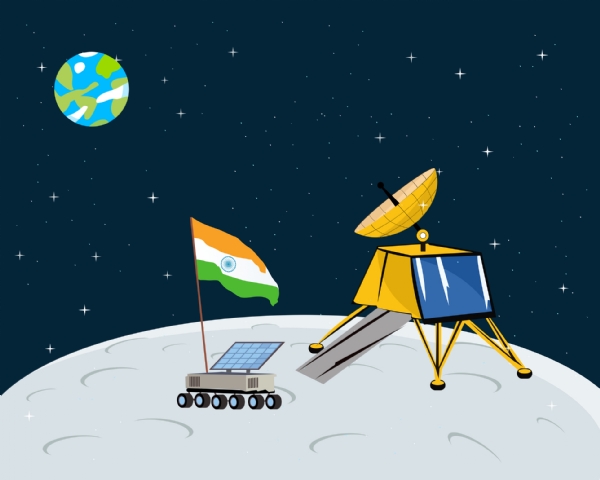
Artist’s representation of Chandrayaan-3 lander near South pole of Moon (iStock images licensed to UKS)
“The landing gives confidence to configure missions to go to the Moon, Mars, Venus, maybe even asteroids”, ISRO chair S. Somanath said at a press briefing”,(Ref. 2).
“……………(Previously) S Somanath has said that theories and principles of science originated in the Vedas, but were taken through the Arab world to the Western countries, where scientists claimed them as their discoveries. Somnath….. asserted that scientific principles for aeronautics, concepts of time, structure of the universe, mathematics, metallurgy and aviation were first found in the Vedas.” (Ref. 3).
An unprovoked surprisingly derogatory response came from the BSS ( Breakthrough Science Society) as a self styled champion of scientific endeavour. “Today’s knowledge based on modern science is far advanced than the ancient knowledge of any civilisation,” the statement read……….. Only a petty mind would think of eulogising achievements of a particular region or section. If superior knowledge in astronomy, aeronautical engineering, etc., is available in the ancient texts in Sanskrit, why isn’t Isro using them? Can he show one piece of technology or theory that Isro has taken from the Vedas and applied to make a rocket or a satellite?” BSS said.
………… Science develops through questioning old ideas and unrealistic claims that our ancient knowledge was superior will confuse the students and hamper the development of a scientific bent of mind. This in effect will only retard the progress of science in India”, the statement added, (Ref. 4).
In previous issues of this periodical, I have elaborated on India’s contributions to today’s world through the binary code, dependent on Vedic invention of the numeral ZERO, and have written on other sites on the Vedic conquest of viruses through the innovative process of inoculation, which paved the way for Jenner’s method of vaccination. Not surprisingly, it took centuries before the West finally credit Bharat with its rightful recognition in these spheres.
Spurred on by Dr. Somnath’s valid assertions and to examine the validity if any, of the unwarranted outburst of BSS, in the wake of Bharat’s stupendous success as the first Nation to land near the South pole of the Moon, I now examine the contribution of Vedic Science to the understanding and knowledge of the Cosmos, of Space, and higher physics concepts, including aviation, atomic theory, atomic fission (nuclear explosion), and space travel.
Dr. Somnath has pointed out the lead taken by Vedic masters in THINKING- “scientific principles” and “concepts”; mockery by BSS on why ISRO did not IMPLEMENT this by building rockets as per Vedic designs are illogical and unwarranted in my humble opinion.
I am therefore, particularly delighted to provide information that USE OF VEDIC TECHNOLOGY DID IN FACT LEAD to the development of the VERY FIRST FLYING AIRCRAFT PROTOTYPE from Vedic designs, BEFORE the WRIGHT BROTHERS, and this was DEMONSTRATED IN 1895 IN BOMBAY ON CHOWPATTY BEACH by an UNSUNG SANSKRIT SCHOLAR, SHRI SHRIKUR BALAJI TALPADE.
This and much more, follows. Hang on for a wonderful ride into Vedic Science.
VEDIC PIONEERING OF SCIENTIFIC THOUGHT - LOOKING BACK TO 7000 BC
“Dick Teresi, author of ‘The God Particle’ and co-founder of Omni magazine, writes in ‘Ancient Roots of Modern Science’, “In India, we see the beginnings of theoretical speculations of the size and nature of the earth. Some 1,000 years before Aristotle, the Vedic Aryans asserted that the earth was round and circled the sun.”
(He went on to say), “Two thousand years before Pythagorus, philosophers in northern India had understood that gravitation held the solar system together, and that therefore the sun, the most massive object, had to be at its center”, (Ref. 9).
Bharat, or the land of the Bharatas, stretches back in Time. Our Vedic civilization is the oldest continuously surviving civilization that follows traditions today that are documented by archaeologists in the Harappan and Sarasvati Civilisations.
“The Indian civilisation is one of the oldest civilisations in the world which, unlike other ancient civilisations, still exists today..”(Ref. 5).
“More evidence of the continuity of the Harappan civilization, traced back to about 8,000 BCE, with the classical Indian culture has emerged”(Ref. 6).
“Vedic literature thus provides us with more original ancient teachings than what we have from all the rest of the world put together…………. many Vedic teachings are known to have been lost. However, the Vedas preserve more unaltered teachings from an early ancient era than we can find elsewhere.” (Ref.10).
History provides proof that marauders and invaders burned down and destroyed huge repositories of manuscripts in renowned educational libraries of Bharat, such as Nalanda, in conflagrations that burned for weeks and months.
It is also acknowledged that currently a vast treasure house of manuscripts is still untouched, awaiting deciphering and translation.
Faced with these lacunae, what can we use to uncover facts about our Vedic heritage?
One approach is to study Bharat’s RIGVEDA, the oldest book in the world known to have been handed down through the ages.
Our Scriptures have been accurately dated using the descriptions of planetary sightings using standard planetarium software; not only is the accuracy of the planetary and astronomical sightings mentioned therein confirmed, but the actual date when these configurations could have occurred has been calculated. The very fact that such descriptions have been recorded as far back as thousands of years BC testify to the accuracy of the recordings, and to the occurrence of events with which these planetary occurrences have been linked.
The scriptures too form a reliable source of information, which have been verified and dated. The Mahabharata is one such book, comprising over a 100,000 verses in 18 sections, and reportedly compiled and embellished over a period of time. The other is the Ramayana, considered to be even older.
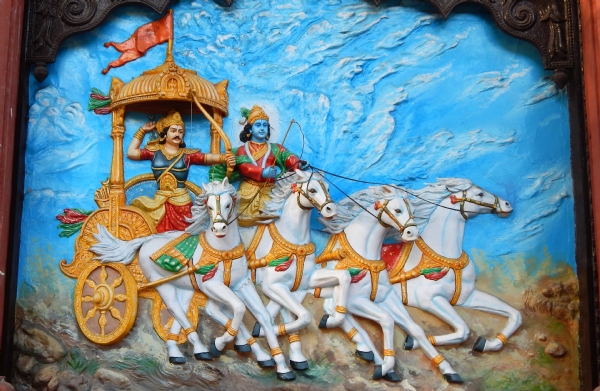
Artist’s representation of Lord Krishna and Prince Arjuna in the Mahabharat (iStock image licensed to UKS).
Written in Sanskrit, they were transmitted by word of mouth, and this ensured their survival over aeons of time, inspite of destruction of manuscripts. Multiple versions of each exist, possibly with additions of local flavour and colour in recounting orally, rendering them a dynamic version of the original. The essence is however unchanged.
The Vedas are another treasure house of information and knowledge which reveal how the Ancient seers and gurus observed, learned, and taught disciples about a host of subjects.
“…..” the question of the science of the Rigveda is of much importance, for it is the oldest complete book that has come down to Mankind.” (Ref.6).
“In 1985 ……………. the Indian National Science Academy (one of the most respected science academies in the world) published a volume, History of Astronomy in India wherein the Harappan civilization and the Brahmana period are correlated, and the Rig Veda is dated to about 7th millennium B.C.”, (Ref. 7).
“Astronomical references in Rigveda represent the sky views of important dates from 7000 BC to 5000 BC (9000 BP-7000 BP)…..
….. There are 53 references in RigVeda as prayers offered to Ashvinis at dawn. The description clearly points to the first sighting of the pair of stars in the Aries constellation just before sunrise (Heliacal Rising) after Winter Solstice to mark the year beginning (Uttarayana)….. The position of Ashvinis (in Aries) matched that of the Winter Solstice about 9000 years ago (7000 BC) as shown in the sky views.”(Ref. 8)
“The Vedic people had a calendar based upon astronomical sightings relative to the equinoctial positions going back from 2000 BC to at least 6000 BC, from the age of Taurus to that of Cancer.This Vedic calendar was modified periodically according to precessional changes which can be documented up to the positions found in Hindu calendars today. It indicates that astronomy and astrology may have originated in India.”(Ref. 10).
It is amazing that such accurate observations were made 9000 years ago by our ancestors, and that they had no advanced instruments to help them do so. It was sheer power of observation, and deep thought applied to them that can explain how it was done.
Clear concepts of the Earth as a spherical planet, of other planets, of the centrality of the Sun, even the distance between each, as well as the elliptical nature of the orbits of each were described. They were a well developed culture in their own right.
“…Hindus had the knowledge that the sun is the center of the solar system…. at a time in history when the rest of the world did not know how to think, talk and write”, (Ref. 9).
“The Vedic culture had cities, villages, and nomadic people made of stone, plastered brick, and metal reinforcement…… They had herds of cattle, horses, and camels in the tens of thousands. They had horse-drawn chariots and ships with oars and sails for travel. They worked in gold, metal, clay, stone, wood, leather, and wool and had a high development of arts and crafts, as well as astrology, medicine, music, dance, and poetry.” (Ref. 10, Pg 33).
VEDIC CONCEPTS OF PLANETS and COSMOS
The Earth and the solar system
“The elliptical orbits in the solar system were known to our ancient seers (Satpatha Brahmana), and the reflected light of the Moon was described many centuries BC in Taittiriya Samhita.”(Ref.6).
“The fact that the planets also had their own elliptical orbits was also understood in ancient days of India as we read in the Rig Veda (Mandalam 1, Suktam 164, mantra 2), “The elliptical path through which all the celestial bodies move is imperishable and unslackened.” It was only later when Johannes Kepler (1571-1630) proposed that the path of all the planets and other celestial bodies is elliptical. 6 (Ref. 9).
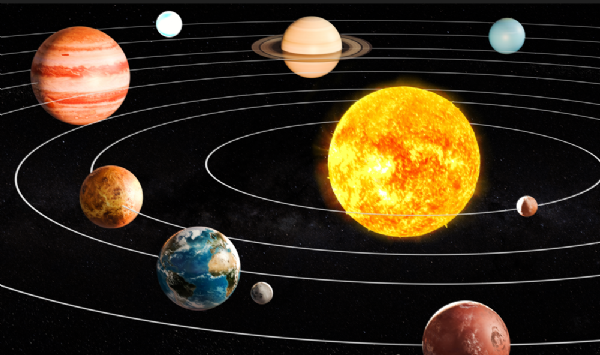
Diagram of Solar system showing elliptical orbits and Earth with Her Moon (iStock image licensed to UKS)
It is truly inspiring that the Vedas described what was known to the West only 8000 years later!
“….Taittiriya-samhita, Kandah 3, Prapatakah 4, Anuvakah 10, mantra 34[of the Yajurveda]) … stated, “The sun holds the earth and the celestial region. The sun is the attracting power [by its gravitational pull]….. And this is further elaborated in books such as the Vishnu Purana (Book 2, chapter 8, verse 15)”. (Ref. 9).
" Many hundreds of years before those great European pioneers, Galileo and Copernicus, …………… the Vedas known as the Brahmanas contained this astounding statement:
‘The sun never sets or rises. When people think the sun is setting, he only changes about after reaching the end of the day and makes night below and day to what is on the other side. Then, when people think he rises in the morning, he only shifts himself about after reaching the end of the day night, and makes day below and night to what is on the other side. In truth, he does not set at all.’ (Ref.12).
“Modern scientists measured the distance between the Sun and the Earth for the first time in 1672 ……….. as 22,000 times of the Earth’s radius (Total Distance: 220000 x 6371 = 140,162,000 km)…….. The well renowned Hanuman Chalisa, authored by Goswami Tulsidas who was born in the 15th century ……… is known to have accurately provided the distance between the Sun and our planet Earth. …………..(worked out to 153,600,000 kms from the Sun) this scientific information was discovered (in Bharat) 2 centuries before the 17th century scientists (Jean Richer and Giovanni Domenico Cassini). ………. .(Ref. 13).
Note that Tulsidas’s 15th century estimate is closer to NASA’s current estimate of 150.34 kms than that of Cassini in 1672 AD !!!! (Ref. 13a).
“What India calculated thousands of years ago, for example the wobble of the Earth's axis, which creates the movement called precession of the equinoxes – the slowly changing motion that completes one cycle every 25,920 years – has only recently been validated by modern science……. they had mathematical/astronomical understanding that is extremely precise and agrees with many of the results of astronomy today.” (Ref. 14).
The values of sidereal revolution times for different planets as mentioned in the Surya Siddhanta ( a Sanskrit treatise dated 4th to 5th Century AD) tally accurately with estimates of modern times.
Mars:686 days, 23 hrs, 56 mins, 23.5 secs and 686 days,(SS) versus 23 hours, 30 mins and 41.4 secs (modern).
So also Mercury 87 days, 23 hours, 16 mins and 22.3 secs compared to 87 days, 23 hours, 15 mins, and 43.9 secs respectively.
Jupiter, Venus and Saturn too are comparable as also the Earth. (ref. 15).
“The antiquity of the earliest Vedic calendar has been calculated as 7000 BCE based on references to solstices and equinoxes within the Vedic literatures.”
“French astronomer Jean-Claude Bailly corroborated the antiquity and accuracy of the Vedic astronomical measurements as, “more ancient than those of the Greeks or Egyptians.” And that, “the movements of the stars calculated 4500 years ago, does not differ by a minute from the tables of today.” (Ref.: 20).
In an age when there was NO PRECEDENT, NO HALLMARK, NO STANDARD to follow, these geniuses were blazing a glorious trail of vision and laying down principles of science where NONE EXISTED BEFORE. They have NEVER BEEN CREDITED FOR THIS PIONEERING THOUGHT AND CONCEPTS, which is the objective of this article, to unearth and present their glory for Bharat, and for the world to see.
THE CREATION OF THE UNIVERSE
“There is a cosmic logic in the narratives of Indian civilisation about the past……. time is not linear, but cyclic, where the cycles of existence and destruction (withdrawal or dissolution) of the universe are eternally interchanged…..... A cycle of existence (Sk. kalpa, ‘eon’) …… equal to 4.32 billion earth years, followed by ….. the same length (cycle of dissolution).” (Ref. 5, pg 141) and (Ref. 11).
"The Hindu religion is the only one of the world's great faiths dedicated to the idea that
the Cosmos itself undergoes an immense, indeed an infinite, number of deaths and rebirths. It is the only religion in which the time scales correspond, to those of modern scientific cosmology.” (Ref. 16).
“Hindu cosmology matches the current understanding of our Universe. The primary evidence put forth for that argument is the number 4.32 billion years from Vishnu Purana which is quite close to the current estimate of the age of the Earth – 4.5 billion years.” (Ref.: 17)
“The Big Bang theory is the prevailing cosmological model for the birth of the universe. ………. most accepted .. by the scientist community [05].
“Before the big bang there was no space, time or matter. There was just singularity where the entire un-manifested universe existed. This is very similar to the Hindus creation myth saying in the beginning nothing existed and the world was beneath the ocean in an un-manifested form.
“….. the universe was created from nothing and the earliest state was “gloom hidden in gloom” as declared in the Vedas (ancient scripture). Both the Rig Veda and Brahmanda Purana describe a universe that is cyclical or oscillating and infinite in time…….. It expanded from a concentrated form — a point called a Bindu [23]”(Ref.: 18)
“The Nasadiya Sukta (of the Rigveda) states
Darkness there was at first, by darkness hidden;
….. Whence was it produced? Whence is this creation?
….. Perhaps it formed itself, or perhaps it did not;
Only He who is its overseer in highest heaven knows,
“Only He knows, or perhaps He does not know.
–6[56][57][58] — Rigveda 10:129 (Ref. 19).

Image of dark skies as visualised in the beginning of Creation, (iStock image licensed to UKS).
“The word Hiranya in Vedic literature stands for brilliancy, glitter or glow. A stotra (kandik. chap.7) of Satapatha Brahmana defines Hiranya …… (it) represents the everlasting glow of eternal fundamental particles.”…” This glowing fire ball refers to the glowing initial mass of matter that appeared at the beginning of cosmos,”(Ref. 19a).
The Hiranya, described thousands of years ago in Vedic scriptures, thus resembles the concept of the singularity particle.
These ancient Vedic concepts influenced thinking around the globe.
“Cosmology and other scientific accomplishments of ancient India spread to other countries along with mercantile and cultural exchanges.” (Ref. 20).
THE SPEED OF LIGHT
…in the Shloka.…. attributed [10, pp. 67] to the son of Kanva Maharshi (4000 B.C.).
the speed of light would be …… 2202 Yojanas/Nimishardha (Ref. 21).
“As per the Rig Veda (calculated from the estimate of 2,202 yoianas in half a nimisha)the speed of light is 189,547 miles per second. As per modern science the speed of light is 186,000 miles per second!(Ref 22).
FLYING VEHICLES AND SPACECRAFT IN VEDIC SCRIPTURES
“When was the idea of space travel or even flight first conceived?
…………we find that the earliest reference is in the Vedas, India’s ancient books of wisdom. Here, vimanas, or flying machines are mentioned quite regularly.”(REF. 20)
“References from Vedic literatures The following ancient literatures mention Vimanas (Ratha, air chariots, airplanes, spaceships and spacecrafts) and propulsion systems.
3.1 The Rig Veda, the oldest document of the human race includes references to the following types of Vimanas and propulsion [5].
A vimana designed to operate in water and air (Rig Veda 6.58.3)
A vimana that operate in ground and water (Rig Veda 9.14.1)
A three wheeled vimana designed to operate in air (Rig Veda 4.36.1)
A vimana powered by wind or gas (Rig Veda 5.41.6)
A vimana powered by solar energy (Rig Veda 3.14.1).
3.2 Yajur Veda Yajur Veda 10.19 quotes the following [6].
Royal skilled engineers built sea boats propelled on water.
Vimanas move and fly upward in the midst of clouds.
Vimanas move as boats on water and fly over clouds.
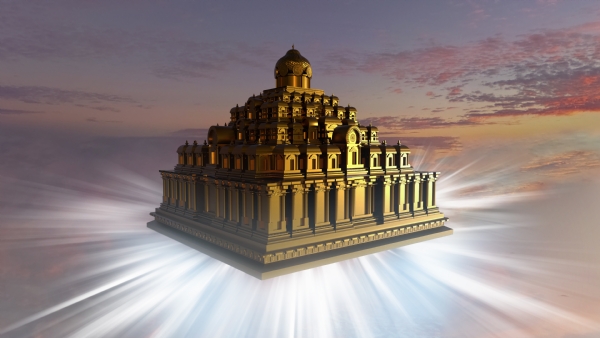
Diagrammatic representation of Vimana from Vedic descriptions. (iStock image licensed to UKS).
3.3 Srimad Bhagavatham (sixth canto, para 3) describes king Citaketu traveling in the outer space on a brilliantly effulgent airplane given by Lord Vishnu.”(Ref. 23).
“Wright brothers demonstrated on December 17th 1903 that it was possible for a manned, heavier than air machine to fly. But in 1895, eight years earlier, the Sanskrit scholar S.B.Talpade designed a basic aircraft called Marutsakthi based on Vedic technology and it took off unmanned before a large audience in the Chowpathy beach of Bombay. Talpade was the first creator of an aircraft in modern times [1].”…. 108 years ago, S.B.Talpade, a Sanskrit scholar of Bombay was able to use the knowledge of Vaimanika Shastra to produce sufficient thrust to lift his aircraft 1500 feet into the air.”
“ During the Vedic period (10,000 AD) in ancient India, the flying machine was called Ratha and later vimana. The Vimanas were used for travel from one place to another place, from one country to another and between the planets.”
“Ion and plasma thrusters are used in many spacecrafts for interplanetary missions [4]. Mercury vortex propulsion cited in Vedic texts is the forerunner for ion thrusters.”
“Mahabharata
Flying Vimanas were cited at 41 places in Mahabharata….. . According to Drona parva, Vimanas are described as sphere shaped and move at great speed generated by mercury propulsion. The Vimanas moved like an UFO going up, down, backwards and forwards. Varna parva, section XLIII describes the aerial journey of Arjuna to Amravati, city of Indra. Arjuna observed Vimanas stationed properly, frequent landing and takeoff. Thousands of celestial Vimanas capable of going everywhere at will and stationed in proper place.”(REF. 23)
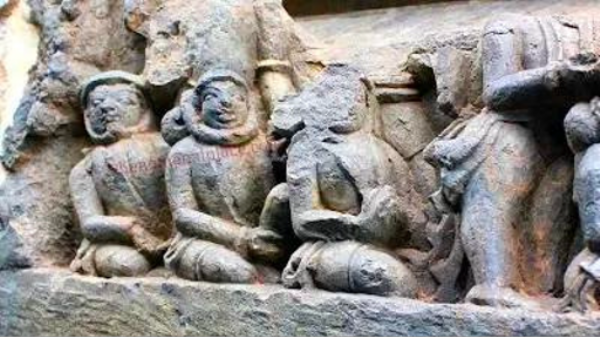
(This is an illustration from “MAGNIFICENT BHARAT” publ: CORONATION; [AN INITIATIVE TO BRING AWARENESS ABOUT OUR GREAT LAND TO THE YOUNGER GENERATIONS] Public Domain on WhatsApp.)
It is a reproduction of a carving on a pillar of the 12th Century Hoysaleshwara Temple at Halebidu Karnataka.
The explanation is from Ref. 24.
Are these astronauts wearing spacesuits? Notice the long sleeved tunics with snug wristbands; helmet like structures show wires attached to a spherical structure at the back.
“…… the city of Indra which Arjuna saw was delightful and was the resort of Siddhas and Charanas. And it was adorned with the flowers of every season, and with sacred trees of all kinds. -------he beheld there celestial cars by thousands, capable of going everywhere at will, stationed in proper places. And he saw tens of thousands of such cars moving in every direction. (Vana Parva, XLIII: 97)”…… “Nivatakavacas, “clad in airtight armor,” which can hardly be anything but a space suit. (Van Buitenen, 1975: 202)”(Quoted in Ref. 25).
ATOMIC THEORY AND NUCLEAR EXPLOSION
“India was also known for its atomic theory that it had developed, way before any such thoughts had appeared in Greece….the system had assumed a definite shape by about the sixth century B.C.
This was the Vedic concept of the atomic nature of things, based on the atom. Kanada propounded that the Parmanu (atom) was the essential, indestructible particle of matter, which could be divided no further. However, when two Parmanus of one substance combined, a dwinuka or binary molecule would form.” (Ref. 9)
“Estimated to have lived sometime between 6th century to 2nd century BCE, ….. traditional name "Kaṇāda" means "atom eater", and he is known for developing the foundations of an atomistic approach to physics and philosophy in the Sanskrit text Vaiśeṣika Sūtra” (Ref. 25a).

Atom and its energy. (iStock image licensed to UKS)
“……..the pashupata, a weapon of total destruction, much like the nuclear bomb of recent times. Not only were such advanced concepts mentioned in the Vedas, but they were also practiced.”(Ref. 20)
“Alexander Gorbovsky (1930 - 2003) an expert at the Russian Munitions Agency has written:
“The Mahabharata - an ancient Indian epic compiled 3000 years ago - contains a reference to a terrible weapon. Regrettably, in our age of the atomic bomb, the description of this weapon exploding will not appear to be an exaggeration:
‘.... a blazing shaft possessed of the effulgence of a smokeless fire (was) let off...'.
“…………. The consequences of its use also evoke involuntary associations.
'... This makes the bodies of the dead unidentifiable. ... The survivors lose their nails and hair, and their food becomes unfit for eating. For several subsequent years the Sun, the stars and the sky remain shrouded with clouds and bad weather'.
"This weapon was known as the Weapon of Brahma or the Flame of Indra......". (Ref. 26)
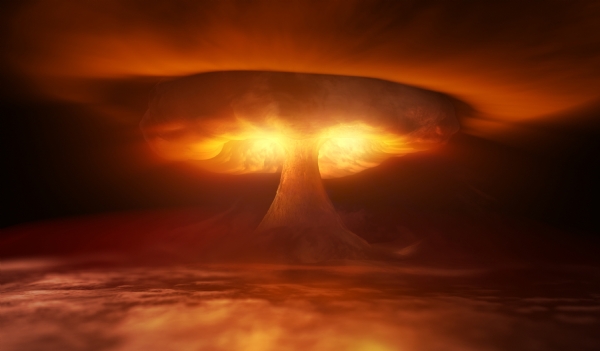
Depiction of possible nuclear explosion described in Mahabharata, (iStock image licensed to UKS).
“Gurkha, flying a swift and powerful vimana (fast aircraft) hurled a single projectile (rocket) charged with the power of the Universe (nuclear device). An incandescent column of smoke and flame, as bright as ten thousand suns, rose with all its splendor. It was an unknown weapon, an iron thunderbolt, a gigantic messenger of death, which reduced to ashes the entire race of the Vrishnis and the Andhakas. The corpses were so burned as to be unrecognizable. Hair and nails fell out; Pottery broke without apparent cause, and the birds turned white .... After a few hours all foodstuffs were infected .... to escape from his fire the soldiers threw themselves in streams to wash themselves and their equipment. (Hartman,1993: 1)”
“Day by day strong winds blew, .... The streets swarmed with rats and mice. Earthen pots showed cracks or broke from no apparent cause. …………… Asses were born of kine, and elephants of mules. Cats were born of bitches, and mouse of the mongoose. (Mausala Parva, 2)”. (Quote verified by author UKS from Source)
“…. the odd birth events of animals demonstrates the probable genetic disorder, both of which are the result of the exposure to the radioactivity, which is very similar to the effects of the explosion in Hiroshima and Nagasaki whose details are given in the report of OTA (1979: 19).”
COMPARISON TO HIROSHIMA and NAGASAKI
“60% of Hiroshima and 30% of Nagasaki were destroyed………………… Thousands died-vaporized, crushed, or burned………….. tens of thousands more who were still alive ………… seeking relief from shock, fire, and pain. Thousands threw themselves into the Ota River, which would be awash with corpses by the end of the day. (Capio, 1995: 66; from Sweet, 1984: 10)”

The ATOMIC DOME; the only structure left standing after the bombing of Hiroshima in 1945; left untouched as a reminder of the horror. (iStock image licensed to UKS).
…. A great deal of people died and many people are still suffering from some diseases the explosion caused at that time. ………….. chromosomal damages yielding mutations in the body of the patients and the future babies, for example, very strange body formations, and insufficient organ mechanisms, like in the scene of the animals in an odd structure told in the Mausala Parva.” (Ref. 25) (Section 16 of Mahabharata, quote verified by author UKS)
CONCLUDING REMARKS:
From the above cited references it will be apparent that Vedic sages and thinkers certainly had an understanding of space, the cosmos, atomic physics, and advanced physics and chemistry. It is inconceivable that these descriptions could have been drawn up had they not had such understanding. I would venture even further to say that they had actually developed and used these inventions; there is just NO WAY that the descriptions off an atomic explosion could have been so accurately been made if this were not so.
Furthermore, the flying vehicle described using ion mercury thrust propellant HAS BEEN CONSTRUCTED AND VERIFIED TO WORK by the late Shri Talpade, a subject of a news article of the experiment at Chowpatty, many years before the Wright brothers launched their model of an airplane.
It is fashionable to decry and berate belief in Vedic science as being unfounded myth.
One may logically ask that if one can believe that seven loaves of bread and a few fish can be transformed to feed thousands of hungry as mentioned in some holy books, why should the same credibility be denied to Vedic science, descriptions of which have been recorded in books written circa 5000 BC? VedVyasa’s mention of certain phenomena in the Mahabharat and Valmiki’s descriptions of warfare in the Ramayan certainly point to an advanced UNDERSTANDING of scientific potential which are only now understood by modern science.
It is inconceivable that imagination could conceive of birth defects from explosions or the darkening skies after nuclear explosions, or the desperate plunging into rivers of the burned victims after the same. Astonishingly, these descriptions closely parallel those of much more recent events, raising the question whether in fact, Vedic science was advanced to a degree that is incomprehensible to doubting minds of today.
If one were to dismiss these as mere theory, why then let us also dismiss the drawings of flying aircraft by Leonardo da Vinci as mere imaginative art, which after all he never even developed a prototype for.
“While we have learned to accept such places as Troy as real and not just legendary, we have dismissed most of the literature of the other ancient cultures as not referring to anything actual or substantial. ……… We assume exaggeration, if not deception, on the part of the ancients rather than giving them credit for what they actually say when it goes against what we believe possible for them.”(Ref. 10).
But, whatever we agree, let us be fair and use the same yardstick for ALL such theories without the bias of skin colour, race, religion, dogma or colonial mentality.
Which brings me to the ridiculous assertions of BSS in their feeble attempt to decry Dr Somnath’s statement of the origins of much Vedic inventions and innovation being plagiarized by the West. My article has dealt with only a few examples with adequate logical referencing.
BSS states that learning about our ancient Vedic thinkers would divert the efforts of budding scientists from the true path of scientific endeavour as plotted by Western thought.
BUT, did not the successful Moon landing of Chandrayan-3 just prove that this DID NOT DETRACT ISRO scientists inspite of, perhaps BECAUSE of Dr. Somnath’s own conviction?
The inability to explain and/or understand a phenomenon should not detract from its acceptance. A scientist should make every possible effort to attempt to explain the phenomenon, and discard ALL preconceived notions which merely argue against it or discredit it.
One should not allow bias and nonacceptance of Vedic greatness to taint the perception of Truth. Above all one must desist from attempts to prejudice people against it merely because one has no awareness of recorded facts.
Let me recount an amusing, almost laughable, situation STEMMING FROM THE MUCH EULOGISED WEST which runs parallel to this inability to understand and accept recorded events from our scriptures. It has been called THE TOMATO EFFECT.
BELIEVE IT OR NOT!!!
In the US in the 1700’s a failure to study the facts led to the rejection of THE TOMATO AS BEING INEDIBLE AND POISONOUS !!!!
YES !!!!!! The tomato was a plant brought to Europe from Peru, and quickly adopted by 1560 AD.
BUT the TOMATO was considered to be POISONOUS in USA and was used only as an ornamental border in gardens.
WHY?
“Tomatoes belong to the nightshade (Solanaceae) family. The word "nightshade" is usually preceded by the word "deadly," and for good reason. The leaves and fruit of several plants in this family, for example, belladonna and mandrake, can cause death if ingested in sufficient quantity……. It simply did not make sense to eat poisonous food.”
“The tomato effect in medicine occurs when an efficacious treatment for a certain disease is ignored or rejected because it does not "make sense" in the light of accepted theories”……. “the tomato effect has stimulated the rejection or nonrecognition of highly efficacious therapies.”(Ref. 21).
I venture to suggest that Vedic-phobes face a similar dilemma, when they discard the awareness creation of our GREAT VEDIC HERITAGE just because it “makes no sense” to them in KNOWING how great and magnificent it truly was. This abject admiration of western thought alone speaks poorly of a scientific approach to the Truth.
Stimulating pride and awe of how wise and inventive our ancestors were would inspire our youth to hold these as life changing examples. To say that Western methods are superior is irrelevant. Admiring the intellect and Truth seeking behaviour of Vedic seers is the first step to experimentation. Who knows where this may have led had we not been invaded and colonized? Medieval pre invasion Bharat was a global example in learning, philosophy, education, hospital building, Medicine, Surgery, architecture, art, literature, craft, metallurgy, and every conceivable channel of thinking.
More on each of these achievements in future issues.
Dear reader, DO NOT let the Tomato effect exemplified by the dismissive approach of naysayers take away from your quest to know about our Vedic Heritage.
Knowledge NEVER impoverishes. Knowledge can only ENRICH. Do not let them deflect you from our GLORIOUS Vedic Heritage. Make it a point to delve deep, study the information coming to the fore, and DEBUNK ALL FALSE NARRATIVE AND FAKE TRUTHS.
Until next time, HAPPY READING!
For references Click here - Download Document
--
Bharati Web





